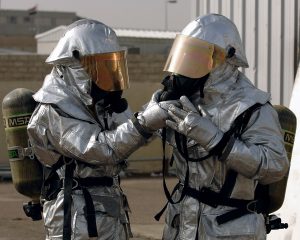Australia has a long history of asbestos use. Between the 1950s and 1970s, the country recorded the highest use of asbestos in the world. It is not surprising when cancer studies show a high incidence of a specific cancer of the mesothelium – a thin layer of tissue that covers most of the internal organs. Extensive research has found the sole cause of this cancer to be asbestos – the set of six minerals that the country has been mining, manufacturing and using extensively.

There were several asbestos mining hubs in Australia. Blue asbestos was endemic to the western regions of the country, particularly Wittenoom. People mined blue asbestos, the most dangerous form of the minerals, in this town from the early 1930s until 1966. That year, the government finally closed the mine down. It wasn’t until the 1970s that the country imposed regulations on the use of asbestos products. People were still using brown asbestos and white asbestos extensively. The last ban came at the end of 2003 that ruled out the use of white asbestos. The rampant use of the minerals to create daily-use products including roofing sheets, shingles, pipelines, insulation linings, and cement means that the majority of this country has encountered asbestos in one form or another.
Who are at higher risks of developing asbestosis, lunch cancer or mesothelioma?
Studies show that people, who have worked in the following industries between the 70s and 80s, have a high risk of developing asbestosis, lung cancer, and mesothelioma. The following professions have increased their exposure and risk considerably –
- Carpentry
- Construction
- Plumbing
- Insulation work
- Electrical engineering
- Shipbuilding
Why is it important to consult professionals for asbestos deconstruction and removal?
Most workplaces adhere to the rules and regulations of Safe Work Australia. The health and safety regulations have laws for asbestos management in the industries, including –
- Removal of asbestos
- Handling all naturally occurring minerals of the category
- Training workers who work in the deconstruction, removal, and sampling department
- The requirement of licenses of the professionals working in abatement
The detailed set of regulations and laws regarding the management and removal of asbestos shows how toxic the material can be.
It is true that older, vintage homes are more likely to contain asbestos in the building materials. However, most of this is the non-friable kind. Without significant agitation, it is unlikely to flake the micro-fibres off and inhale them. However, if you are thinking about undertaking renovation work, you should always consult a local and reputable asbestos testing company. Check out Advanced Deconstruction Brisbane to learn more about sampling and management of asbestos for residential, commercial and industrial sectors.
Is DIY-ing asbestos removal a good idea or a terrible idea?
There are a few things that are unsuitable for DIY projects and asbestos removal from your property is one of them. Professionals have the necessary training, tools, and equipment to manage the threat. In short, it is highly unsafe to attempt to remove asbestos on your own. The urgency and expense of the process might be driving you towards such a drastic decision, but at the same time, you should consider the fact that you are putting your loved ones at a much higher risk by trying to remove the materials in an amateurish way.
Asbestos has microscopic fibres that are stackable, and they can accumulate in one place over time. You must ensure the minimal release of these fibres since these are the fragments that can cause mesothelioma, asbestosis and other forms of lung cancer. These small fragments are highly toxic, and they are powerful enough to trigger chronic illnesses in human beings. You must also ensure to limit personal exposure to this substance. That means a regular overall and a mask is not sufficient to take care of asbestos in your workplace, home or locality. You will need to wear appropriate gear for the process and use the right disposal mechanism that will eliminate the threat of releasing the fibres into the air.
What will you need for DIY asbestos removal from home?
If you are resolute about cleaning up on your own, you might be interested in getting personal protection equipment (PPE). You guessed it right! The costs might be high since you will need more than one, as it is not a one-person’s job. Your mask should be double strapped to hold it in place; you will need heavy goggles, disposable overalls, thick gloves and a hat. Most homeowners do not have this kind of equipment just lying around in the attic or basement. If you do not know where to find the right PPE or what the right PPE for asbestos removal is,it will be much better hiringsome professionals to help you out. You can pack your bags, head out to a family vacation or rent a motel for a couple of days, while the trained folk take over the deconstruction and removal bit. Most importantly, an untrained person can remove only non-friable asbestos as long as it is 10 square meters or less in area.
What should you never do during asbestos removal?
Braving the deconstruction process is usually tedious and trying. That is primarily because you should not use power tools, water blasts, drills, cutters and scrubbers on the construction material. Any process that releases minute quantities of dust into the air can release asbestos as well. You should minimise contact and minimise breakage. Depending on which room you are going to remodel first, remove the furniture carefully without scraping or dragging too much. Water the area (Cement sheet) to keep the dust to a minimal level. Don’t drop the sheets.
Why is cleanup and disposal after deconstruction such a pain?
If you are thinking about opting for asbestos removal and deconstruction inside your home, you should tell your neighbours. They might want a heads-up if you are trying to cut out bits and pieces of your home because they might give you chronic illnesses. Keep your family, pets, and relatives away until the cleanup is complete. The cleanup is another hurdle for the amateur worker. The professionals receive special training so as not to stack the sheets, or skid them before double wrapping. Disposal is a headache since the government has strict rules about throwing asbestos products in landfills. Additionally, do not attempt to sweep or vacuum your home immediately after the work. Only specific heavy-duty vacuum cleaners have the power to suction asbestos fibres and dust.







